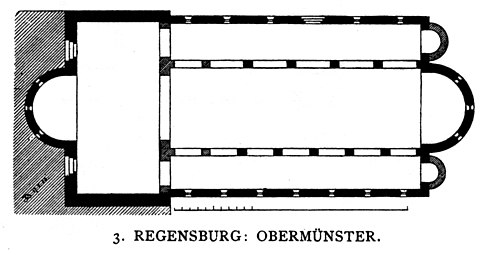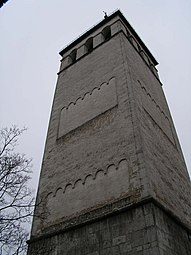Obermünster Abbey (Regensburg)
The Obermünster Abbey was a former canonical monastery in Regensburg . In the early 9th century - at the instigation of Hemma , the wife of Ludwig the German - the monastery was represented as the Reichsabtei Obermünster in the Bavarian Reichskreis and from 1484 had a seat and vote at the Reichstag.The building of the associated church was almost completely destroyed by bombs in March 1945. The ruins are preserved as a memorial. The free-standing tower of the church was preserved undamaged as a campanile , as was the former monastery building.
history
From monastery to imperial abbey
The monastery consecrated to the Assumption of Mary was probably built in the late 8th century by Duke Tassilo III. or founded in the early 9th century by the Carolingian dynasty . There is no clear documentary evidence. In 1010 the monastery was upgraded with donations and the granting of privileges from Heinrich II , who also supported the building of a church. The position as imperial monastery remained controversial, however, and it was not until 1216 that the imperial immediacy of the present imperial abbey was confirmed and consolidated by Frederick II . In 1802 the imperial monastery was subordinated to the new sovereign prince Karl Theodor von Dalberg and dissolved in 1810 in the course of secularization . The residents had the right to stay until 1822, when the last abbess died.
After secularization
Until 1822 the resting place of the last canons , first a clerical seminar and from 1882 the episcopal study seminar St. Wolfgang were set up in the buildings of the monastery .
On March 13, 1945, bombs completely destroyed part of the monastery buildings and the church. The free-standing bell tower was hardly damaged. An altar of the church in the north aisle, donated by Wandula von Schaumberg and built between 1534 and 1540, was only damaged in the gable area, restored and transferred to the Cathedral Treasury Museum. The design of the altar is attributed to Albrecht Altdorfer .
In the preserved war ruins of the church, the Regensburg scouts receive the light of peace from Bethlehem every year .
After the war, the episcopal central archive , the library, some of the diocesan museums and other offices of the diocese were housed in newly constructed buildings.
Obermünsterviertel
After the former Obermünster Abbey, the entire district on the southern edge of the old town of Regensburg between Neupfarrplatz and Petersweg is called the Obermünsterviertel . For a long time, this part of the city was characterized by a rather negative image, caused by a high level of traffic, a large number of amusement places and the resulting high noise pollution and high fluctuation in retail. In June 2011, the district was declared a redevelopment area and included in an urban development promotion program with the aim of redeveloping the building stock, improving the housing supply, creating green and open spaces and reducing traffic and noise pollution. So far, only some of the measures (as of 2019) have been implemented.
Abbesses of Obermünster
- Mathilde around 900/945
- Irmgard
- Salome
- Wikpurg 1020-1029
- ?
- Willa 1052-1089
- Hazecha 1089–?
- Hadamuda 1117
- Hadwiga 1142-1177
- Euphemia von Helffenstein 1193
- Gertrude I. 1216
- Jutta 1259
- Gertrude II. 1265
- Wilburg von Leuchtenberg 1272
- Ryssa I. von Leuchtenberg 1286–1292
- Ryssa II von Dornberg 1299
- Bertha Walterin –1325
- Adelheid von Arenbach
- Katharina von Murach
- Agnes I. von Wunebach -1374
- Elisabeth I of Parsberg 1374–1400
- Elisabeth II of Murach 1400–1402
- Margarethe I. Sattelbogerin –1435
- Barbara von Absberg 1435-1456
- Kunigunde von Egloffstein 1456–1479
- Sibylla von Paulsdorff 1479–1500
- Agnes II von Paulsdorff 1500–?
- Catherine II of Redwitz 1533–1536; † 1560
- Wandula von Schaumberg 1533–1545
- Barbara II of Sandizell –1564
- Barbara III. Ratzin 1564-1579
- Magdalena von Gleissenthal 1579–1594
- Margarethe II. Moufflin 1594–1608
- Katharina Praxedis von Perckhausen 1608–1649
- Maria Elisabeth von Salis 1649–1683
- Maria Theresia von Sandizell 1683–1719
- Anna Magdalena Franziska von Dondorff 1719–1765
- Maria Franziska von Freudenberg 1765–1775
- Maria Josepha von Neuenstein-Hubacker 1775–1803
Buildings
Madonna in the halo or crescent moon Madonna . Unknown artist, 17th century. Today in the parish church of St. Josef in Dingolfing
literature
- Anke Borgmeyer, Achim Hubel, Andreas Tillmann, Angelika Wellnhofer: City of Regensburg, monuments in Bavaria . Volume III.37, Regensburg 1997, pp. 422-433, ISBN 3-927529-92-3 .
- Claudia Märtl: The Obermünster, Niedermünster, St. Paul women's monasteries . In Peter Schmid (Ed.): History of the City of Regensburg , Vol. 2, Friedrich Pustet, Regensburg 2000, pp. 745–763, ISBN 3-7917-1682-4 .
- Paul Mai, Karl Hausberger (ed.): Reichsstift Obermünster in Regensburg then and now. In: Contributions to the history of the diocese of Regensburg. Edition 42, Regensburg 2008
Web links
-
Obermünster Abbey (Regensburg) , basic data and history:
Peter Morsbach: The Reichsstift Obermünster in Regensburg - Foundation of the Carolingians in the database of monasteries in Bavaria in the House of Bavarian History
Individual evidence
- ^ Peter Schmoll: Air raid. MZ Buchverlag Regensburg 1995, ISBN 3-927529-12-5 , p. 191
- ↑ Hubert Kernl: Altars of the Renaissance. The Schaumberg Altar . In: Working Group Regensburg Autumn Symposium (ed.): “Between Gothic and Baroque” traces of the Renaissance in Regensburg . tape 26 . Dr. Peter Morsbach Verlag, Regensburg 2012, ISBN 978-3-937527-55-0 , p. 127-129 .
- ↑ Alexandra Klos, Georgine Adam: The Obermünsterviertel is breaking new ground - shaping the future together . In: 40 years of urban development funding in Regensburg - a success story . City of Regensburg, Planning and Building Department, Office for Urban Development, Regensburg 2011, ISBN 978-3-935052-96-2 , p. 52 .
Coordinates: 49 ° 0 ′ 57.1 ″ N , 12 ° 5 ′ 43.2 ″ E





